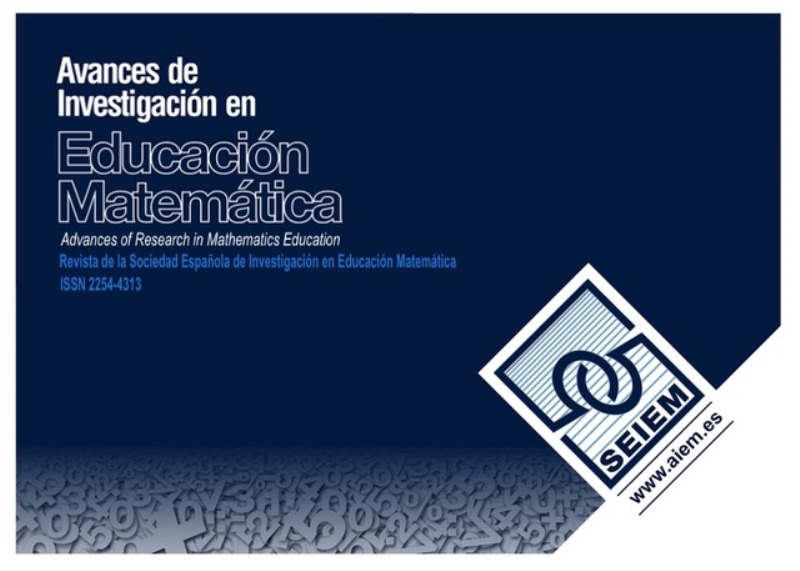Una progresión de la simbolización de estudiantes: Soluciones de un sistema de ecuaciones lineales
DOI:
https://doi.org/10.35763/aiem21.4237Palabras clave:
Sistemas de ecuaciones lineales, Álgebra lineal, Simbolización, Razonamiento de los estudiantes, Educación Matemática ReaísticaResumen
Los sistemas de ecuaciones lineales (SEL) corresponden a un concepto fundamental del álgebra lineal, pero hay relativamente poca investigación, pero hay relativamente poca investigación acerca de la enseñanza y el aprendizaje de los SEL, particularmente de las concepciones de los estudiantes acerca de sus soluciones. Se ha encontrado que la resolución de sistemas con un número infinito de soluciones o sin solución tiende a ser menos intuitivo para los estudiantes, lo cual indica la necesidad de más investigación en la enseñanza y aprendizaje de este tema. Entrevistamos a dos estudiantes de matemáticas que eran también maestros en formación a través de un experimento de enseñanza por parejas para mirar cómo razonaban acerca de las soluciones de SEL en ℝ3. Presentamos los resultados enfocando en la progresión del razonamiento de los estudiantes sobre las soluciones de los SEL a través del lento de simbolización. Documentamos la progresión de su razonamiento como una acumulación de significados numéricos, algebraicos y gráficos coordinados y las simbolizaciones de sus conjuntos solución.
Descargas
Citas
Andrews-Larson, C. J., Siefken, J., & Simha, R. (2022). Report on a US-Canadian faculty survey on undergraduate linear algebra: Could linear algebra be an alternate first collegiate math course? Notices of the American Mathematical Society.
Freudenthal, H. (1973). What groups mean in mathematics and what they should mean in mathematical education. In A.G. Howson (Ed.), Developments in Mathematical Education: Proceedings of the Second International Congress on Mathematical Education (pp. 101-114). Cambridge University Press. https://doi.org/10.1017/CBO9781139013536.006
Freudenthal, H. (1991). Revisiting mathematics education. Kluwer Academic.
Gravemeijer, K. (1999). How emergent models may foster the constitution of formal mathematics. Mathematical Thinking and Learning, 1(2), 155-177. https://doi.org/10.1207/s15327833mtl0102_4
Gravemeijer, K., & Doorman, M. (1999). Context problems in realistic mathematics education: A calculus course as an example. Educational Studies in Mathematics, 39, 111-129. https://doi.org/10.1023/A:1003749919816
Harel, G. (2017). The learning and teaching of linear algebra: Observations and generalizations. Journal of Mathematical Behavior, 46, 69-95. https://doi.org/10.1016/j.jmathb.2017.02.007
Huntley, M. A., Marcus, R., Kahan, J., & Miller, J. L. (2007). Investigating high-school students’ reasoning strategies when they solve linear equations. Journal of Mathematical Behavior, 26, 115-139. https://doi.org/10.1016/j.jmathb.2007.05.005
Larson, C., & Zandieh, M. (2013). Three interpretations of the matrix equation Ax= b. For the Learning of Mathematics, 33(2), 11-17.
Oktaç, A. (2018). Conceptions about system of linear equations and solution. In S. Stewart, C. Andrews-Larson, A. Berman, & M. Zandieh (Eds.), Challenges and strategies in teaching linear algebra (pp. 71–101). Springer.
Possani, E., Trigueros, M., Preciado, J.G., & Lozano, M. D. (2010). Use of models in the teaching of linear algebra. Linear Algebra and its Applications, 432, 2125-2140. https://doi.org/10.1016/j.laa.2009.05.004
Rasmussen, C., & Marrongelle, K. (2006). Pedagogical content tools: Integrating student reasoning and mathematics in instruction. Journal for Research in Mathematics Education, 37(5), 388-420.
Rasmussen, C., Wawro, M. & Zandieh, M. (2015). Examining individual and collective level mathematical progress. Education Studies in Mathematics, 88(2), 259-281. https://doi.org/10.1007/s10649-014-9583-x
Rasmussen, C., Zandieh, M., King, K. & Teppo, A. (2005). Advancing mathematical activity: A practice-oriented view of advanced mathematical thinking. Mathematical Thinking and Learning, 7, 51-73. https://doi.org/10.1207/s15327833mtl0701_4
Saldaña, J. (2021). The coding manual for qualitative researchers. Sage.
Sandoval, I. & Possani, E. (2016). An analysis of different representations for vectors and planes in R3: Learning challenges. Educational Studies in Mathematics, 92, 109-127. https://doi.org/10.1007/s10649-015-9675-2
Smith, J., Lee, I., Zandieh, M., & Andrews-Larson, C. (2021). Two students’ conceptions of solutions to a system of linear equations. In Proceedings of the 22nd Annual Conference on Research in Undergraduate Mathematics Education.
Smith, J., & Thompson, P. W. (2007). Quantitative reasoning and the development of algebraic reasoning. In J. J. Kaput, D. W. Carraher & M. L. Blanton (Eds.), Algebra in the early grades (pp. 95-132). Erlbaum
Steffe, L. P., & Thompson, P. W. (2000). Teaching experiment methodology: Underlying principles and essential elements. In R. Lesh & A. E. Kelly (Eds.), Research design in mathematics and science education (pp. 267-307). Erlbaum.
Wawro, M., Zandieh, M., Rasmussen, C., & Andrews-Larson, C. (2013). Inquiry oriented linear algebra: Course materials. http://iola.math.vt.edu
Zandieh, M. & Andrews-Larson, C. (2019). Symbolizing while solving linear systems. ZDM, 51, 1183-1197. https://doi.org/10.1007/s11858-019-01083-3
Zandieh, M., Wawro, M., & Rasmussen, C. (2017). An example of inquiry in linear algebra: The roles of symbolizing and brokering, PRIMUS, 27(1), 96-124, https://doi.org/10.1080/10511970.2016.1199618
Descargas
Publicado
Cómo citar
Número
Sección
Licencia
Derechos de autor 2022 Jessica L. Smith, Inyoung Lee, Michelle Zandieh, Christine Andrews-Larson

Esta obra está bajo una licencia internacional Creative Commons Atribución 4.0.
Los trabajos se publican bajo una licencia de Creative Commons: Reconocimiento 4.0 España a partir del número 21 (2022).
Los autores que publican en esta revista están de acuerdo con los siguientes términos:
- Los autores conservan los derechos de autor y el reconocimiento de la autoría.
- Los textos publicados en esta revista están sujetos –si no se indica lo contrario– a una licencia de Reconocimiento 4.0 Internacional de Creative Commons. Puede copiarlos, distribuirlos, comunicarlos públicamente, hacer obras derivadas y usos comerciales siempre que reconozca los créditos de las obras (autoría, nombre de la revista, institución editora) de la manera especificada por los autores o por la revista. La licencia completa se puede consultar en http://creativecommons.org/licenses/by/4.0.
- Los autores pueden establecer por separado acuerdos adicionales para la distribución no exclusiva de la versión de la obra publicada en la revista (por ejemplo, situarlo en un repositorio institucional o publicarlo en un libro), con un reconocimiento de su publicación inicial en esta revista.
- Se permite y se anima a los autores a difundir sus trabajos electrónicamente (por ejemplo, en repositorios institucionales o en su propio sitio web) antes y durante el proceso de envío, ya que puede dar lugar a intercambios productivos, así como a una citación más temprana y mayor de los trabajos publicados (Véase The Effect of Open Access) (en inglés).









